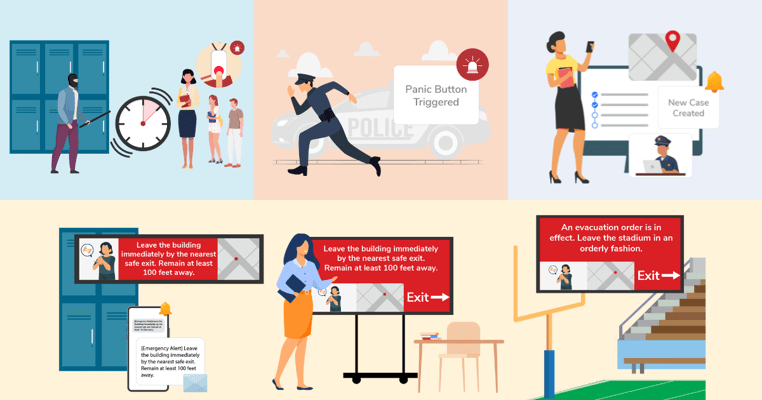The K-12 school year is underway, and the ever-present topic of school safety has likely led to watercooler conversations amongst staff, parents and, naturally, the student population.
In recent years, the number of emergency or violent incidents that are reported within the K-12 school ecosystem has shown a noticeable increase, with the more high-profile events – usually involving an active shooter and fatal injuries – generating news headlines and calls for school safety to be both a state and nation priority.
For students, teachers and parents, these events are an unwanted reality of what it means to attend a K-12 school in the 21st century. This aligns with the duty of care that school districts and administrators have to the wider community.
It is not hyperbole to say that effective and intuitive school safety protocols can save lives, even more so when staff do not have to second-guess how to respond to an unpredictable incident but use available resources or tools instinctively. In 2025, those responses are usually aligned with pressing a button.
Simply put, the most effective tools and strategies are the ones that facilitate accurate incident identification, notification, and response, and eliminate communication breakdowns. In other words, it is imperative in the modern school system that people are empowered to do the right thing at the right time with the right tool.
In this blog post we take a deeper dive into how panic buttons enhance school safety, what they are, and why they are a critical part of the protocols and processes that align with existing Panic Alert Systems for K-12 School Safety.
What are Panic Button Systems for K-12 Schools?
A panic button is an emergency alert device that allow staff to quickly notify first responders such as the police, fire, or EMS during critical incidents. This device can be fixed (mounted on a wall), wearable (badges or lanyards), or virtual (mobile app). In today’s connected society, they can also be integrated with VoIP phones or intercom systems.
From a K-12 school safety perspective, integrating this sort of technology has not always been top-of-mind for decision makers. Rather, they prefer to stick with traditional norms, some of which take a reactive as opposed to proactive attitude to risk management.
As we noted in a recent blog post, the panic button is more than just a tool, it’s a connection.
Panic buttons can be an outlier when it comes to upgrading existing safety protocols, but there is a consensus that state-centric legislation such as Alyssa’s Law – which calls for the installation of silent panic alarms in schools that are directly linked to law enforcement - is slowly moving the needle forward.
At the time of writing, there are over ten states that have passed legislation that require some form of Panic Button Solutions in schools with nearly twenty currently “in progress” as regards its adoption – you can access the full list here.
That is good news for the student population and staff in those states. The caveat is that a lack of a federal mandate for widespread adoption of Alyssa’s Law legislation means that there are a sizable number of school districts across the country that are not required to prioritize Panic Button Solutions for K-12 Schools. This puts this particular school safety tool firmly in the category of work-in-progress.
A recent industry study cited by CampusSafety said that safety and security tools vary widely from school to school, with emergency drills, access control, video surveillance, and safety resource officers considered to be the norm. Emergency communications initiated by teachers are, the study said, more likely to be based around hardware such as a walkie-talkie or radio, with only 7 percent of 530 respondents to a survey saying that they used a panic button to trigger an alert on campus.
In addition, we need to acknowledge that the first people aware of an emergency are often teachers or onsite staff, which makes it even more important that an integrated solution such as a panic button be part of, and not separate from, a multi-faceted school safety strategy. Sadly, that is not as easy as it sounds.
According to the study, there are oft-cited barriers to improving school safety. We have highlighted these pain points in previous Kokomo24/7® blogs, but they are worth repeating and include:
- Lack of funding
- Lack of Leadership Focus
- Understaffing
- Inadequate staff safety training
- Lack of adoption of school safety tools
In addition, school IT administrators are under-resourced or lack time to enhance or improve school safety policies, which are often within a fragmented and siloed ecosystem. IT teams therefore face expanding scopes of responsibilities, which leads to rising costs and operational inefficiencies.
At Kokomo24/7®, we believe a holistic platform approach to school safety is the best path to adopt across the entire ecosystem. Time is critical when dealing with an emergency incident, so integrating a health and safety platform that can deal with a multitude of unforeseen events in one solution must be a priority for school admins and decision makers.
Panic Button Solutions: What To Look For
As we have noted above, panic button integration is becoming more widespread, but they are not (at least not yet) always considered to be a critical part of school safety protocols. The question that needs to be asked is how to make panic buttons the go-to tool when an emergency incident occurs at a K-12 school.
That means we need to think about the benefits they bring, and the pain points they solve. If we tackle the tech aspect first, an effective and efficient panic button system must have the following elements as a bare minimum:
- Silent activation
- Location awareness
- Integration with existing safety protocols
- Multi-device options (wearables, fixed buttons, app-based)
- Legislative compliance (Alyssa’s Law, for example)
Additionally, they must be able to meet certain implementation requirements, such as:
- Infrastructure readiness; onsite Wi-Fi, network coverage, power backup
- Training: Staff need to know how to both use the system and when (false alarms or accidental activations can impact emergency response, while a steep learning curve can limit its usefulness).
- Placement: panic buttons should be installed in high-risk areas (classrooms, reception, nurse’s office), with non-fixed options widely available.
- Policy Integration: solutions must align with existing emergency protocols, workflows, and safety drills
If the Panic Button Solution fits all of the above criteria, then the benefits will include but not be limited to:
- Faster emergency response, and critical minutes saved
- Improved safety for the onsite population (students, staff, visitors) and the wider community.
- Discrete incident or risk management
- Reduction in the feelings of helplessness that can be part of an emergency incident, such as an active shooter or medical situation
- Enhanced trust and staff empowerment, which fits into the culture of care.
All of these identified factors are a critical part of choosing the right Panic Alert Systems for K-12 Safety. In other words, the alert solution has to not only tick the boxes in terms of embedded features but also leverage the next-generation tech currently available.
The Kokomo24/7® panic button solution has been built to facilitate a quick response to any incident. The simple act of pressing the button on a wearable device (an ID badge, for example), via a mobile app or as a fixed point on a wall sets everything in motion.
Alerts can then be triggered and the location pinpointed for first responders. In addition, the school can also send notifications through SMS, email, the PA system, and integrated onsite signage. This allows school administrators to manage everything in one place on one holistic platform.

Why Panic Buttons Matter
Naturally, the concept of a panic button to sound a discrete and silent alarm that alerts authorities or staff to an onsite incident is nothing new. Banks, for instance, have used this technology since the early 1960s.
School safety is part of day-to-day operations for the school. That means that it must have the same level of attention as educational or staff priorities. Schools are part of the local community, so ensuring that effective and efficient safety workflows are in place will generate both a circle of trust and peace-of-mind.
This might seem obvious but knowing where the current pain points are and where the school community is vulnerable is a critical part of any discussion.
The first step that any K-12 school administrator or decision maker needs to take is to evaluate what their safety needs are and where any gaps exist. Panic Button Solutions can help to fill that gap.
According to a report by Virtue Market Research, the focus in school safety is now on providing not only a secure learning environment but also peace of mind for staff, parents and the community itself. This focus, the report said, is linked to the technological advances in digital safety systems in the last five years that “redefine the future of educational safety.”
Around 89% of educational institutions prioritize safety technology investments, while 82% of parents feel reassured by student safety solution implementation, the report noted. In addition, 91% of educators believe safety solutions enhance the learning environment. That makes panic buttons an integral part of not only a multi-faceted school safety strategy, but an easy-to-use solution within that environment.
Panic Button Systems Make Schools Safe
The culture of care that schools provide in 2025 is predicated on maintaining physical and digital safety, while reducing the potential for unexpected events and, by association, putting the student population in danger.
Panic buttons are designed to be part of that conversation, especially in a modern society where on-site emergencies or violent incidents are rarely predictable. Pressing a button might be a simple act, but it has the potential to save lives and make our K-12 schools safer.
To find out more about how Kokomo24/7®’s Panic Button Solutions can enhance your school safety protocols, contact us today for a demo!

About Kokomo24/7®
Since 2018, Kokomo24/7®’s configuration-based platform has helped over 120 national and global organizations respond quickly to safety, wellness, and compliance needs. From visitor management to behavioral threat assessment and emergency alerts, Kokomo24/7® powers holistic school safety for a better everyday experience.
 CASES™
CASES™ ESCALATE™
ESCALATE™ TRIAGE™
TRIAGE™ NOTIFY™
NOTIFY™ FORMS™
FORMS™ ANALYTICS™
ANALYTICS™ HOST™
HOST™ OWLPASS®
OWLPASS® ACCESS™
ACCESS™ WELLNESS™
WELLNESS™ CONNECT™
CONNECT™ CREDENTIALS™
CREDENTIALS™


